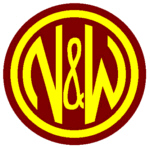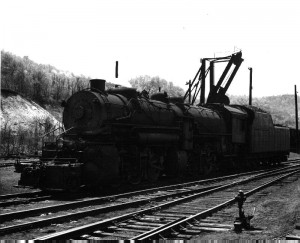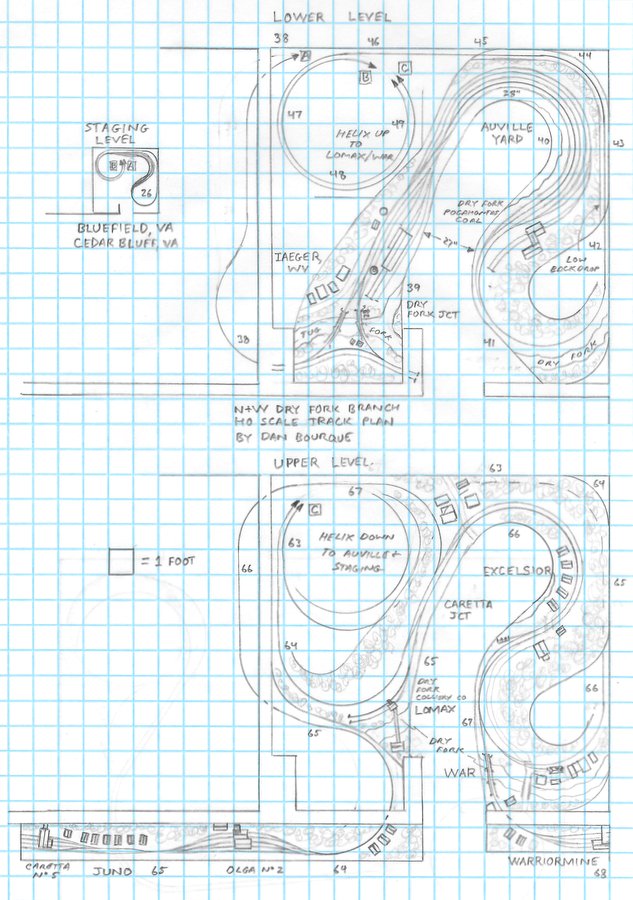- Size: 15′ x 24 ′
- Scale: HO
- Minimum Radius: 30″ (except 28″ on non-mainline tracks as noted)
- Minimum Aisle Width: 27″
- Designed by Dan Bourque
 The Norfolk & Western’s Dry Fork Branch was a major artery through the coalfields of southern West Virginia. The branch connected to the Pocahontas Division mainline along the Tug Fork at Iaeger, WV to the north and to the Clinch Valley Sub to the south at Cedar Bluffs, VA. The heart of the Dry Fork Branch was the yard at Auville, WV, near Iaeger, where mine runs were assembled and mine run power kept.
The Norfolk & Western’s Dry Fork Branch was a major artery through the coalfields of southern West Virginia. The branch connected to the Pocahontas Division mainline along the Tug Fork at Iaeger, WV to the north and to the Clinch Valley Sub to the south at Cedar Bluffs, VA. The heart of the Dry Fork Branch was the yard at Auville, WV, near Iaeger, where mine runs were assembled and mine run power kept.
The Layout
This track plan represents a few key portions of the Dry Fork Branch in the 1940s. This was an era of transition for the branch as many of the smaller, older tipples along the river had already closed, but the larger, more modern prep plants like Olga No 2 on the Caretta Branch had not yet been built. During this time frame, a smaller number of older tipples were producing at max capacity to feed the needs of WWII, and passenger trains still roamed the rails.
I’ve listed this plan as both a “bedroom-sized” and “garage-sized” plan because its overall dimensions are large, but at its heart, it’s a bedroom-sized plan with a few extensions. For a bedroom-sized plan, this layout would pack a lot of heavy coalfield action into a small space. This plan, drawn for a real space in a basement, takes advantage of a utility area (upper right) and two bookshelves in an adjacent den to expand the operations. While it’s designed to be operated point-to-point, the entire layout forms a long continuous running loop which is perfect for someone who wants to operate realistically but still likes to just sit back and watch trains run.
The lower deck represents the heart of the branch, Auville Yard, and the adjacent engine terminal and junction. The track arrangements are compressed significantly but still contain all the key features those familiar with the area would need: the two bridges on the wye, DY tower, the concrete coaling tower, and the long engine house. The yard is meant to be visible staging for coal hoppers (see the operations section). It’s about half the tracks and much shorter than the prototype, but it still captures the narrow, snaky nature of the prototype that’s sandwiched between the tall hills and the Dry Fork riverbed. Rounding out the lower level is the small tipple for Dry Fork Pocahontas Coal which was adjacent to the yard, modeled here with stub tracks to save space. To avoid a long run of inaccessible track, the line from Auville Yard to the helix is hidden in plan sight behind a low backdrop behind the yard (trees and hills in front to hide the trains from sight, painted hills and sky in back).
The upper deck represents the branch between Lomax and War, WV, a busy spot in the middle of the branch about 20 miles from Iaeger/Auville. In this area were two sidings and two branches, the Caretta Branch to Juno, WV and War Creek Spur to Warriormine, WV. I’ve compressed the distance between the towns and combined the two sidings into one (the passing siding at Excelsior). Included along the main are the small loader for Dry Fork Colliery Company at Lomax which loaded from across the river, and the two small sidings near War for the station and a coal dealer. The War Creek Spur is modeled in a very compressed way, but it allows the modeling of the tipple at Warriormine, the last operation standing in the 1940s. The Caretta Branch, like the War Creek Spur, also extends over bookshelves in the den area of the layout. It captures two of the loaders on the branch, Olga No 2 (the original before the prep plant) and Caretta No 5, both of which were very active in the 1940s. Overall, the upper deck is designed to capture the feel of the stereotypical Appalachian branch line with tracks, rivers, roads and company houses all crammed into narrow valleys.
The magic of this layout is what’s behind the scenes. From War on the upper deck, the tracks snake under the Caretta Branch and down the helix to a 4-5 track double-ended staging yard beneath Auville representing the rest of the Dry Fork Branch and the connection at Cedar Bluffs, VA. Each track is about 15 feet long, enough to hold a 2-8-8-2, a cab, and about 30-35 55 ton hoppers. The other end of the staging yard represents Bluefield, VA, and it connects to Iaeger via the helix as well. This double-ended staging yard makes the entire layout a continuous running loop. Because of the engine terminal and long mainline run, this layout would benefit greatly from DCC, and a larger system with a booster and walk-around throttles would be needed.
Operations
This layout has enough going on to keep one or many operators busy, but the narrow and small aisle would probably limit operating sessions to 2-3 operators (2 in the aisle, 1 in the den). The focus of operations would be moving coal from the branch to Bluefield and moving empties from Bluefield to the branch, a scheme made limitless by the continuous nature of the layout. Most trains would be “mainline” trains and “through mine runs” simulating the movement of coal and empties between the major yard at Bluefield and mines on the Dry Fork Branch beyond War, WV. The endless scheme works like this. A mainline train of empties starts its run in Bluefield staging and brings its empties through Iaeger and into Auville Yard. The empties are dropped in the yard and the motive power, likely a 2-8-8-2 Mallet, would be turned on the wye at Dry Fork Junction and moved to the engine facilities for servicing. The crew then picks up a string of loaded hoppers from Auville Yard and takes them back to Bluefield. From Bluefield, the same train could keep running through the Cedar Bluffs end of staging and show up on the upper deck as a mine run of loads returning from the tipples beyond War. After traversing the upper deck and making its way to Auville, the mine run would drop its string of loads in the yard, turn the locomotive on the wye, and head to the engine facilities. After servicing, the crew (or another crew) would take the locomotive back to the yard to take a string of empty hoppers (the ones dropped off earlier) back up the helix and through the upper deck to the mines beyond War. Upon arriving in Cedar Bluff staging, the train now becomes the next mainline train of empty hoppers from Bluefield to start the cycle all over again. This could be happening with two crews simultaneously with occasional meets between loads and empties at Excelsior.
The modeled tipples would also require two mine runs, one for the Caretta Branch and one for the War Creek Spur and tipples along the Dry Fork. These trains, also powered by 2-8-8-2s, would depart with a separate string of empties, placing them along the way and pulling loads to be returned to the yard where another mainline crew might take them down to Bluefield (another train ready to be recycled as a mine run from beyond War). Finally, a small passenger train would round out the mix, making daily stops at Iaeger, Caretta Jct (Yukon), Excelsior, and War. Variety could be added by simulating construction, congestion or a wreck on the Bluefield main requiring additional coal trains and through freights to divert over the Dry Fork Branch. Overall, this layout crams some big operation in a small space with the added bonus of endless operation using recycled trains and the continuous running loop.
Things I Like About this Plan:
- Continuous running loop and endless operation
- Good mix of yard, engine facilities, tipples and scenery for a smaller space
Things I Don’t Like About this Plan:
- Tight aisles (not many “sidings” for people)
- Lots of holes in walls
- Lots of hidden track in the helix
- Very compressed
Related Products:





